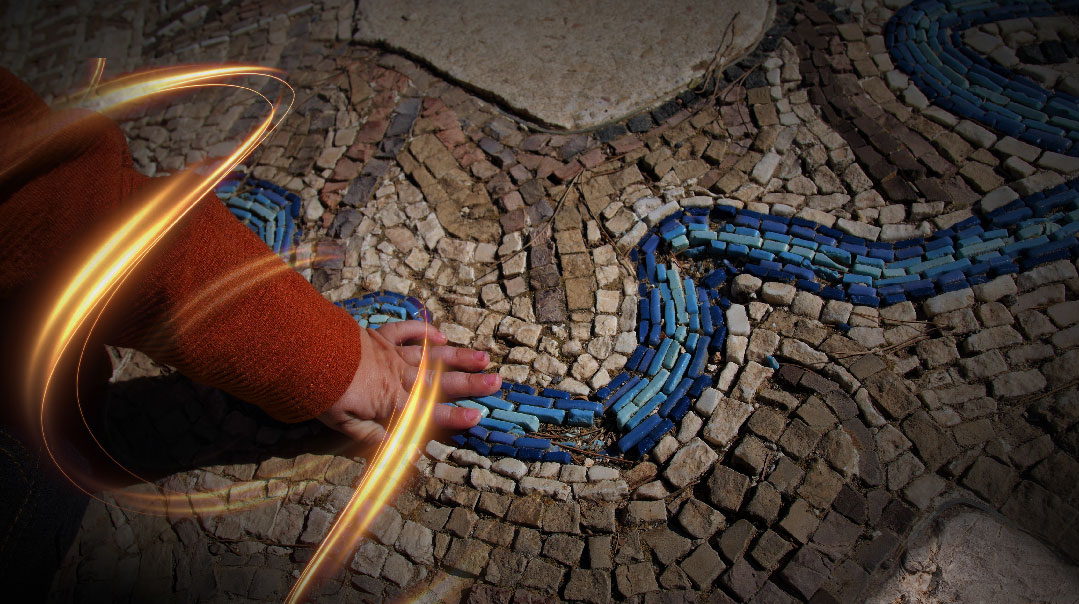He Who Sends the Rain


T
he November sun is strong, but there’s a chill in the air I hadn’t expected. Autumn has crept up from behind in its mixed-up glory, blustery clawing tendrils and floaty leaves sashaying down to earth. I berate myself for not bringing sweaters as I lock the car, strap the baby in the stroller, and cross the street toward the Haas Promenade in Armon Hanatziv, Yerushalayim.
But as I reach the lookout point and the view rises up before me, all thoughts of sweaters disappear. The city is splayed out in glistening gold and white before me. It’s breathtaking.
Har Habayis sits in the center, enclosed within the walls of the Old City, while the new city flutters like wings around it. Even my little guy is entranced. But this view isn’t why I came here today. I turn south, heading toward a park dotted with pine trees, a few minutes away.
That’s where I find what I’m looking for — a little mound of history embedded in the land of a thousand layers. Within a small enclosure in this inconspicuous area sits a shaft and reservoir that dates back to the times of the Chashmonaim. Forty-three meters below lies an ancient aqueduct that runs from Breichat Shlomo, Solomon’s Pool, located south of Beit Lechem, to Har Habayis. It’s hard to convey in words quite how far, and just how hilly, that route is, but believe me, it’s impressive.
During the Bayis Sheini period, the small Gichon spring located near the Beis Hamikdash could no longer provide sufficient water for the masses, and new water sources were desperately needed.
In an unbelievable feat of engineering, the Chashmonaim built an aqueduct that ran 21 kilometers long, and successfully brought the much-needed water into Yerushalayim. However, the Armon Hanatziv ridge where I’m standing right now posed a unique problem — the water couldn’t flow upward and over the ridge. To solve the problem the Chashmonaim tunneled through the mountain, coming in through the top via a number of shafts, ensuring the water could flow straight through the middle of the ridge.
Today you can walk through the tunnels, and much of the original design can still be seen, including a section near the Kosel. Improvements were made to the water channel over time, and the aqueduct was actually used on and off for over 2,000 years, up until 1967.
A beautiful mosaic map sits nearby, depicting the trajectory of the water from the Chevron foothills, past Beit Lechem, through the Armon Hanatziv ridge, down to Sultan’s Pool in Gai Ben Chinnom, then around Har Tzion, entering the city just west of Shaar Ha’ashpot and ending just beyond the Kosel.
Yet despite creating a state-of-the art aqueduct, we know Klal Yisrael never stopped their tefillos for rain, never lost sight of the fact that one can create the most technologically advanced water channel, but it is He Who provides the water to fill it. All the digging and tunneling and great minds cannot create rain to fill the pools, nor keep the springs from drying up.
A little over a year ago I wrote in these pages about my struggle with hyperemesis gravidarum (“What Goes Down Must Come Up,” October 3, 2018). Writing is always hard, but this piece was like lassoing a tornado. I wrote it in between torrents of tears, squeezing my eyes shut and traveling backward to find the dark heavy things, then dragging them up to my fingers and turning them into prose. I had to confront everything I’d spent a year trying to forget.
A grueling two weeks later, I felt much better. I’d done my best to write my authentic experience, including any details fit to print, and I knew my vulnerability lent some power to the piece.
Yet I wasn’t prepared for the feedback I’d receive after I sent my words flying. The response was overwhelming. Women told me they cried right through it, how cathartic it was to find their silent suffering had a voice at last. Mothers told me they showed it to close friends and relatives with a sense of relief, finally able to describe what they’d endured by pointing to the article and saying this is what it is.
Some women couldn’t read it, unable or unprepared to go back to that place. Others shared how the article gave them the chizuk they needed to feel less alone throughout their difficult pregnancy, knowing someone else had been there.
Maybe in a tiny way, I was able to chisel a bit off the “everyone’s a little nauseous in pregnancy, just deal with it” block. Not only is it insensitive to lump every expectant woman’s experience together, it can be downright dangerous.
Since then I’ve gotten many e-mails asking for advice, and sitting on my current feeling-great-and-not-throwing-up pedestal, I dispense it with ease.
“You need to stay hydrated,” I say. “That means taking your medication on time so you can keep down fluids. The more hydrated you stay, the less nauseous you’ll feel. When you throw up, you lose fluid. The more fluid you lose, the more you’ll throw up. The more you throw up, the worse it gets.”
It’s a cycle, I tell them. “Beat the cycle. If you see your lips are dry, get an IV before the dehydration gets worse. Modern medicine has so much to offer.”
I can say these things now because I’m not lying motionless, unable to move or talk, sinking slowly into a bottomless sandy hourglass. I can write these things because at the moment, it takes me five seconds to down a cup of water, not five hours. But then, something will make me stop. I’ll sit down and remember a time not too long ago when a cup of water was reverse Everest. Getting to the bottom seemed utterly impossible; every sip was a battle for life.
And in those moments when the memories flood me, I tell myself to slow down. Travel back. Stop assuaging yourself by administrating pushy advice because here’s the very hard truth: Sometimes we can take all the right medication, get IVs when we need them, finish a whole entire yellow Gatorade, and still find HG clinging on for dear life.
We can use the tools modern medicine has to offer, but in the end, He decides the rainfall. He decides how hydrated we’ll be, He decides what sort of pregnancy we’ll have. In that release of power there is some comfort. “I’ve done my best, but this is what I’ve been given and this is what I have to deal with. I can try my hardest to take care of myself, but I can’t change everything.”
I give advice because I want to help, I want to fix, I want everyone to be hydrated and plump and gaining weight and able to walk and talk and function. But maybe instead of lecturing, I should take out a siddur and daven for all the HG sufferers out there who are too weak to daven for themselves. Because at the end of the day, our own two hands will only get us part of the way.
It is He Who sends the rain.
(Originally featured in Family First, Issue 673)
Oops! We could not locate your form.












